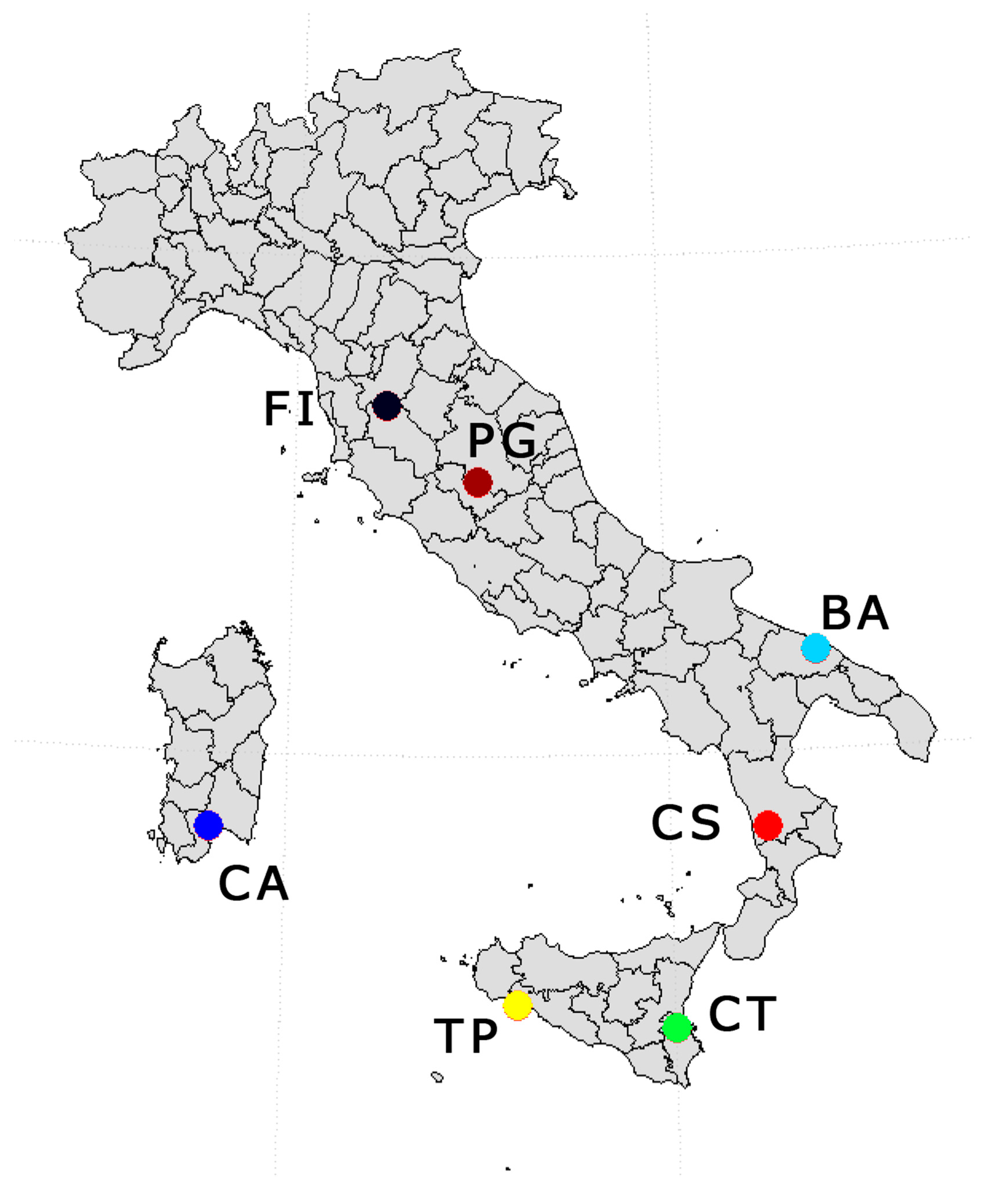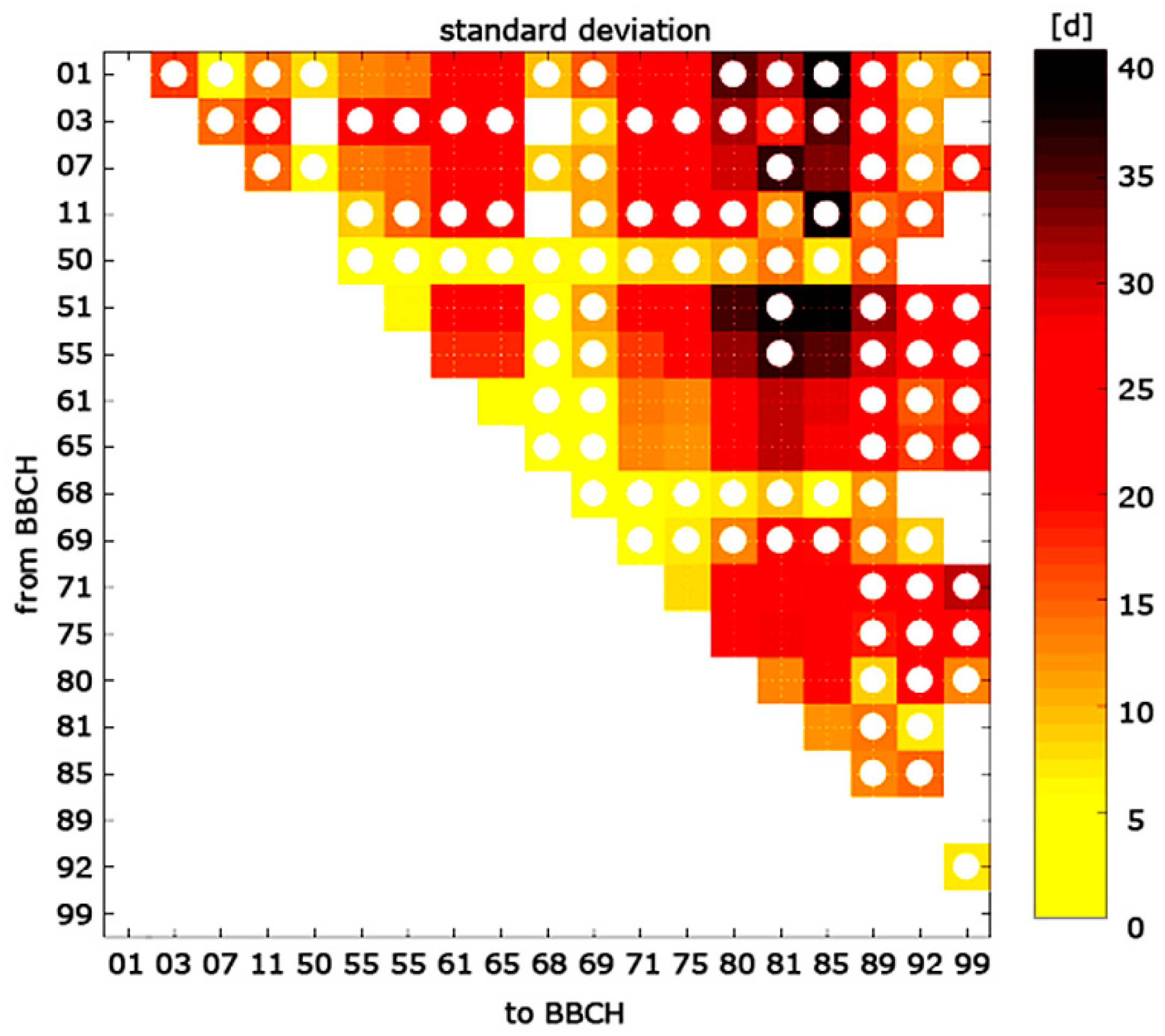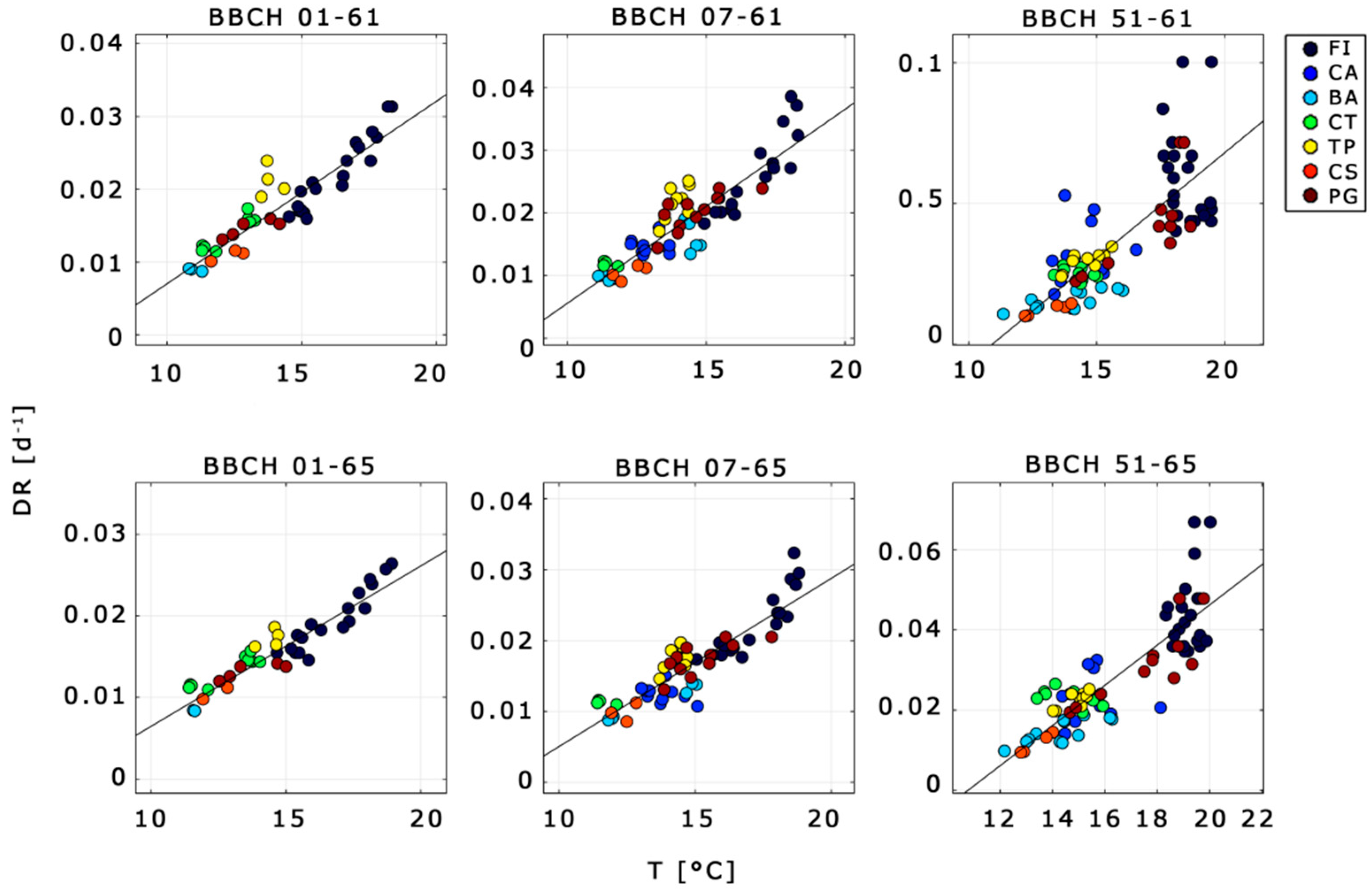A Phenological Model for Olive (Olea europaea L. var europaea) Growing in Italy
Abstract
1. Introduction
2. Materials and Methods
2.1. Data Source
2.2. Developmental Rate (DR) Function
2.2.1. Linear DR Function
2.2.2. Nonlinear DR Function
2.2.3. Using DRs to Simulate Olive Phenology
- Equation (1) when a simple linear DR is adopted:
- Equation (2) when both temperature and daylength are explanatory variables:
- Equation (3) when nonlinear DR is adopted as follows:
2.3. K-Fold Cross-Validation (KfCV) and Final Model Calibration
3. Results
4. Discussion
5. Conclusions
Supplementary Materials
Author Contributions
Funding
Institutional Review Board Statement
Informed Consent Statement
Data Availability Statement
Acknowledgments
Conflicts of Interest
References
- Connor, D.J. Adaptation of olive (Olea europaea L.) to water-limited environments. Aust. J. Agric. Res. 2005, 56, 1181–1189. [Google Scholar] [CrossRef]
- Caracuta, V. Olive growing in Puglia (southeastern Italy): A review of the evidence from the Mesolithic to the Middle Ages. Veg. Hist. Archaeobotany 2020, 29, 595–620. [Google Scholar] [CrossRef]
- Ponti, L.; Gutierrez, A.P.; Ruti, P.M.; Dell’Aquila, A. Fine-scale ecological and economic assessment of climate change on olive in the Mediterranean Basin reveals winners and losers. Proc. Natl. Acad. Sci. USA 2014, 111, 5598–5603. [Google Scholar] [CrossRef] [PubMed]
- Alcalá, A.R.; Barranco, D. Prediction of Flowering Time in Olive for the Cordoba Olive Collection. HortScience 1992, 27, 1205–1207. [Google Scholar] [CrossRef]
- Recio, M.; Cabezudo, B.; Trigo, M.D.M.; Toro, F.J. Accumulative air temperature as a predicting parameter for daily airborne olive pollen(Olea europaea L.) during the pre-peak period in Málaga (Western Mediterranean area). Grana 1997, 36, 44–48. [Google Scholar] [CrossRef]
- Fornaciari, M.; Pieroni, L.; Ciuchi, P.; Romano, B. A Statistical Model for Correlating Airborne Pollen Grains (Olea Europaea L.) with Some Meteorological Parameters. Agric. Mediterr. 1997, 127, 134–137. [Google Scholar]
- Osborne, C.P.; Chuine, I.; Viner, D.; Woodward, F.I. Olive phenology as a sensitive indicator of future climatic warming in the Mediterranean. Plant Cell Environ. 2000, 23, 701–710. [Google Scholar] [CrossRef]
- Galán, C.; García-Mozo, H.; Vázquez, L.; Ruiz, L.; De La Guardia, C.D.; Trigo, M.M. Heat requirement for the onset of the Olea europaea L. pollen season in several sites in Andalusia and the effect of the expected future climate change. Int. J. Biometeorol. 2005, 49, 184–188. [Google Scholar] [CrossRef]
- Aguilera, F.; Fornaciari, M.; Ruiz-Valenzuela, L.; Galán, C.; Msallem, M.; Ben Dhiab, A.; La Guardia, C.D.-D.; Trigo, M.D.M.; Bonofiglio, T.; Orlandi, F. Phenological models to predict the main flowering phases of olive (Olea europaea L.) along a latitudinal and longitudinal gradient across the Mediterranean region. Int. J. Biometeorol. 2014, 59, 629–641. [Google Scholar] [CrossRef]
- López-Bernal, Á.; García-Tejera, O.; Testi, L.; Orgaz, F.; Villalobos, F.J. Studying and modelling winter dormancy in olive trees. Agric. For. Meteorol. 2020, 280, 107776. [Google Scholar] [CrossRef]
- Rojo, J.; Orlandi, F.; Ben Dhiab, A.; Lara, B.; Picornell, A.; Oteros, J.; Msallem, M.; Fornaciari, M.; Pérez-Badia, R. Estimation of Chilling and Heat Accumulation Periods Based on the Timing of Olive Pollination. Forests 2020, 11, 835. [Google Scholar] [CrossRef]
- Aguilera, F.; Ruiz, L.; Fornaciari, M.; Romano, B.; Galán, C.; Oteros, J.; Ben Dhiab, A.; Msallem, M.; Orlandi, F. Heat accumulation period in the Mediterranean region: Phenological response of the olive in different climate areas (Spain, Italy and Tunisia). Int. J. Biometeorol. 2013, 58, 867–876. [Google Scholar] [CrossRef]
- Navas-Lopez, J.F.; León, L.; Rapoport, H.F.; Moreno-Alías, I.; Lorite, I.J.; De La Rosa, R. Genotype, environment and their interaction effects on olive tree flowering phenology and flower quality. Euphytica 2019, 215, 184. [Google Scholar] [CrossRef]
- Bonofiglio, T.; Orlandi, F.; Sgromo, C.; Romano, B.; Fornaciari, M. Influence of temperature and rainfall on timing of olive (Olea europaea) flowering in southern Italy. N. Z. J. Crop. Hortic. Sci. 2008, 36, 59–69. [Google Scholar] [CrossRef]
- Oteros, J.; García-Mozo, H.; Vázquez, L.; Mestre, A.; Domínguez-Vilches, E.; Galán, C. Modelling olive phenological response to weather and topography. Agric. Ecosyst. Environ. 2013, 179, 62–68. [Google Scholar] [CrossRef]
- Rojo, J.; Pérez-Badia, R. Effects of topography and crown-exposure on olive tree phenology. Trees 2014, 28, 449–459. [Google Scholar] [CrossRef]
- Flynn, D.F.B.; Wolkovich, E.M. Temperature and photoperiod drive spring phenology across all species in a temperate forest community. New Phytol. 2018, 219, 1353–1362. [Google Scholar] [CrossRef]
- Imaizumi, T.; Kay, S.A. Photoperiodic control of flowering: Not only by coincidence. Trends Plant Sci. 2006, 11, 550–558. [Google Scholar] [CrossRef] [PubMed]
- De Melo-Abreu, J.P.; Barranco, D.; Cordeiro, A.M.; Tous, J.; Rogado, B.M.; Villalobos, F.J. Modelling olive flowering date using chilling for dormancy release and thermal time. Agric. For. Meteorol. 2004, 125, 117–127. [Google Scholar] [CrossRef]
- Garcia-Mozo, H.; Orlandi, F.; Galán, C.; Fornaciari, M.; Romano, B.; Ruiz, L.; De La Guardia, C.D.; Trigo, M.M.; Chuine, I. Olive flowering phenology variation between different cultivars in Spain and Italy: Modeling analysis. Theor. Appl. Clim. 2008, 95, 385–395. [Google Scholar] [CrossRef]
- Picornell, A.; Buters, J.; Rojo, J.; Traidl-Hoffmann, C.; Damialis, A.; Menzel, A.; Bergmann, K.; Werchan, M.; Schmidt-Weber, C.; Oteros, J. Predicting the start, peak and end of the Betula pollen season in Bavaria, Germany. Sci. Total Environ. 2019, 690, 1299–1309. [Google Scholar] [CrossRef] [PubMed]
- Landis, D.A.; Wratten, S.D.; Gurr, G.M. Habitat Management to Conserve Natural Enemies of Arthropod Pests in Agriculture. Annu. Rev. Entomol. 2000, 45, 175–201. [Google Scholar] [CrossRef]
- Ghersa, C.M.; Holt, J.S. Using phenology prediction in weed management: A review. Weed Res. 1995, 35, 461–470. [Google Scholar] [CrossRef]
- Andres, L.A.; Goeden, R.D. The Biological Control of Weeds by Introduced Natural Enemies. In Biological Control: Proceedings of an AAAS Symposium on Biological Control, Held at Boston, Massachusetts, 30–31 December 1969; Huffaker, C.B., Ed.; Springer: Boston, MA, USA, 1971; pp. 143–164. ISBN 978-1-4615-6531-4. [Google Scholar]
- Van Asch, M.; Visser, M.E. Phenology of Forest Caterpillars and Their Host Trees: The Importance of Synchrony. Annu. Rev. Entomol. 2007, 52, 37–55. [Google Scholar] [CrossRef] [PubMed]
- Herms, D. Using Degree-Days and Plant Phenology to Predict PestActivity. In IPM (Integrated Pest Management) of Midwest Landscapes; Minnesota Agricultural Experiment Station: St. Paul, MN, USA, 2004; Chapter 11. [Google Scholar]
- Fraga, H.; Pinto, J.G.; Santos, J.A. Climate change projections for chilling and heat forcing conditions in European vineyards and olive orchards: A multi-model assessment. Clim. Chang. 2019, 152, 179–193. [Google Scholar] [CrossRef]
- Orlandi, F.; Ruga, L.; Romano, B.; Fornaciari, M. Olive flowering as an indicator of local climatic changes. Theor. Appl. Clim. 2005, 81, 169–176. [Google Scholar] [CrossRef]
- Moriondo, M.; Leolini, L.; Brilli, L.; Dibari, C.; Tognetti, R.; Giovannelli, A.; Rapi, B.; Battista, P.; Caruso, G.; Gucci, R.; et al. A simple model simulating development and growth of an olive grove. Eur. J. Agron. 2019, 105, 129–145. [Google Scholar] [CrossRef]
- Charalampopoulos, I.; Polychroni, I.; Psomiadis, E.; Nastos, P. Spatiotemporal Estimation of the Olive and Vine Cultivations’ Growing Degree Days in the Balkans Region. Atmosphere 2021, 12, 148. [Google Scholar] [CrossRef]
- Mariani, L.; Alilla, R.; Cola, G.; Monte, G.D.; Epifani, C.; Puppi, G.; Osvaldo, F. IPHEN—A real-time network for phenological monitoring and modelling in Italy. Int. J. Biometeorol. 2013, 57, 881–893. [Google Scholar] [CrossRef]
- Botarelli, L.; Brunetti, A.; Pasquini, A.; Zinoni, F. Progetto Finalizzato PHENAGRI. In Vol. 1—Aspetti Generali Delle Osservazioni Agrofenologiche; Ministero delle Politiche Agricole e Forestali, Collana di Agrofenologia: Roma, Italy, 1999. [Google Scholar]
- Raschka, S. Model Evaluation, Model Selection, and Algorithm Selection in Machine Learning. arXiv 2020, arXiv:1811.12808. [Google Scholar]
- Bernati, E.; Botarelli, L.; Cosentino, S.; Ferraresi, A.; Nieddu, G.; Sirca, C. La conduzione agronomica ed il rilevamento agrofenologico nelle prove sperimentali. In Progetto Finalizzato PHENAGRI. In Vol. 1—Aspetti Generali Delle Osservazioni Agrofenologiche; Ministero delle Politiche Agricole e Forestali, Collana di Agrofenologia: Roma, Italy, 1999. [Google Scholar]
- Sanz-Cortes, F.; Martinez-Calvo, J.; Badenes, M.L.; Bleiholder, H.; Hack, H.; Llacer, G.; Meier, U. Phenological growth stages of olive trees (Olea europaea). Ann. Appl. Biol. 2002, 140, 151–157. [Google Scholar] [CrossRef]
- Angus, J.; Mackenzie, D.; Morton, R.; Schafer, C. Phasic development in field crops II. Thermal and photoperiodic responses of spring wheat. Field Crop. Res. 1981, 4, 269–283. [Google Scholar] [CrossRef]
- Slafer, G. Differences in phasic development rate amongst wheat cultivars independent of responses to photoperiod and vernalization. A viewpoint of the intrinsic earliness hypothesis. J. Agric. Sci. 1996, 126, 403–419. [Google Scholar] [CrossRef]
- Worner, S.P. Performance of Phenological Models Under Variable Temperature Regimes: Consequences of the Kaufmann or Rate Summation Effect. Environ. Entomol. 1992, 21, 689–699. [Google Scholar] [CrossRef]
- Rojo, J.; Pérez-Badia, R. Models for forecasting the flowering of Cornicabra olive groves. Int. J. Biometeorol. 2015, 59, 1547–1556. [Google Scholar] [CrossRef] [PubMed]
- Atkinson, D.; Porter, J.R. Temperature, plant development and crop yields. Trends Plant Sci. 1996, 1, 119–124. [Google Scholar] [CrossRef]
- Jochner, S.; Sparks, T.; Laube, J.; Menzel, A. Can we detect a nonlinear response to temperature in European plant phenology? Int. J. Biometeorol. 2016, 60, 1551–1561. [Google Scholar] [CrossRef]
- Allen, R.G.; Pereira, L.S.; Raes, D.; Smith, M. Crop evapotranspiration-Guidelines for computing crop water requirements-FAO Irrigation and drainage paper 56. FAO Rome 1998, 300, D05109. [Google Scholar]
- Pal, R. Chapter 4—Validation Methodologies. In Predictive Modeling of Drug Sensitivity; Pal, R., Ed.; Academic Press: Cambridge, MA, USA, 2017; pp. 83–107. ISBN 978-0-12-805274-7. [Google Scholar]
- Aybar, V.E.; De Melo E Abreu, J.P.M.; Searles, P.S.; Matias, A.C.; Del Rio, C.; Caballero, J.M.; Rousseaux, M.C. Evaluation of olive flowering at low latitude sites in Argentina using a chilling requirement model. Span. J. Agric. Res. 2015, 13, e0901. [Google Scholar] [CrossRef]
- Zhang, T.; Li, T.; Yang, X.; Simelton, E. Model biases in rice phenology under warmer climates. Sci. Rep. 2016, 6, 27355. [Google Scholar] [CrossRef] [PubMed]
- Piña-Rey, A.; Ribeiro, H.; Fernández-González, M.; Abreu, I.; Rodríguez-Rajo, F. Phenological Model to Predict Budbreak and Flowering Dates of Four Vitis vinifera L. Cultivars Cultivated in DO. Ribeiro (North-West Spain). Plants 2021, 10, 502. [Google Scholar] [CrossRef] [PubMed]
- Mancuso, S.; Pasquali, G.; Fiorino, P. Phenology Modelling and Forecasting in Olive (Olea Europaea L.) Using Artificial Neural Networks. Adv. Hortic. Sci. 2002, 16, 155–164. [Google Scholar]
- Oses, N.; Azpiroz, I.; Quartulli, M.; Olaizola, I.; Marchi, S.; Guidotti, D. Machine Learning for olive phenology prediction and base temperature optimisation. In Proceedings of the 2020 Global Internet of Things Summit (GIoTS), Dublin, Ireland, 3–5 June 2020; pp. 1–6. [Google Scholar]
- Garrido, A.; Fernández-González, M.; Álvarez-López, S.; González-Fernández, E.; Rodríguez-Rajo, F.J. First phenological and aerobiological assessment of olive orchards at the Northern limit of the Mediterranean bioclimatic area. Aerobiologia 2020, 36, 641–656. [Google Scholar] [CrossRef]
- Rapoport, H.F.; Costagli, G.; Gucci, R. The Effect of Water Deficit during Early Fruit Development on Olive Fruit Morphogenesis. J. Am. Soc. Hortic. Sci. 2004, 129, 121–127. [Google Scholar] [CrossRef]
- Inglese, P.; Famiani, F. I fattori di variabilità genetici, ambientali e colturali della composizione dell’olio di oliva. Italus Hortus 2009, 16, 67–81. [Google Scholar]
- Rodríguez, R.; Villalba, M.; Monsalve, R.I.; Batanero, E. The Spectrum of Olive Pollen Allergens. Int. Arch. Allergy Immunol. 2001, 125, 185–195. [Google Scholar] [CrossRef] [PubMed]
- Maracchi, G.; Pittalis, F.; Bindi, M.; Sillari, B. La Produzione Dell’olivo Ei Fattori Meteorologici Studio preliminare. Olivae 1994, 52, 30–37. [Google Scholar]





| Site | Latitude | Longitude | Varieties |
|---|---|---|---|
| Montepaldi (Tuscany, FI) | 43.66 | 11.14 | Carolea, Coratina, Picholine, Frantoio, Leccino, Moraiolo, Pendolino |
| Villasor (Sardinia, CA) | 39.38 | 8.91 | Carolea, Coratina, Picholine, Bosana, Tonda di Cagliari |
| Valenzano (Apulia, BA) | 41.03 | 16.85 | Carolea, Coratina, Picholine, Nocellara Etnea |
| Torre Alegra (Sicily, CT) | 37.41 | 15.00 | Carolea, Coratina, Picholine, Moresca, Tonda di Iblea |
| BeliceMAre (Sicily, TP) | 37.60 | 12.85 | Carolea, Picholine, Biancolilla, Nocellara Etnea, Nocellara Messinese |
| Rende (Calabria, CS) | 39.36 | 16.23 | Carolea, Coratina, Picholine, Cassanese, Nocellara Messinese |
| Prepo (Umbria, PG) | 42.99 | 12.26 | Carolea, Coratina, Picholine, Frantoio, Moraiolo |
| BBCH Scale | Description |
|---|---|
| 01 | Foliar buds start to swell and open |
| 03 | Foliar buds lengthen and separate from base |
| 07 | External small leaves open, not completely separated |
| 11 | First leaves completely separated |
| 50 | Inflorescence buds leaf axils completely closed |
| 51 | Inflorescence buds start to swell |
| 55 | Flower cluster totally expanded |
| 61 | Beginning of flowering |
| 65 | Full flowering, at least 50% of flowers open |
| 68 | Majority of petals fallen or faded |
| 69 | End of flowering, non-fertilized ovaries fallen |
| 71 | Fruits at 10% of final size |
| 75 | Fruits at 50% of final size |
| 80 | Fruit becoming light green or yellowish |
| 81 | Beginning of fruit coloring |
| 85 | Increasing specific fruit coloring |
| 89 | Harvest maturity |
| 92 | Overripe with fruits that start to fall |
| 99 | At least 50% of fruits fallen |
| From BBCH | To BBCH | r2 | p-Value | RMSE [days] | MSE [days] | S * (St. Dev) [days] | N. Sites | N. Data | |
|---|---|---|---|---|---|---|---|---|---|
| 01 | 61 | Model of Equation (1) | 0.95 | 2.0 × 10−5 | 4.7 | −0.3 | 64 (22) | 6 | 50 |
| Model of Equation (2) | 0.96 * | 2.7 × 10−6 | 4.3 | −0.8 | |||||
| Model of Equation (3) | 0.93 | 6.1 × 10−4 | 6.4 | −3.2 | |||||
| 07 | 61 | Model of Equation (1) | 0.93 | 3.6 × 10−7 | 5.6 | −0.5 | 60 (22) | 7 | 71 |
| Model of Equation (2) | 0.93 * | 2.9 × 10−7 | 5.6 | −0.59 | |||||
| Model of Equation (3) | 0.92 | 9.8 × 10−7 | 7.1 | −3.1 | |||||
| 51 | 61 | Model of Equation (1) | 0.93 | 1.2 × 10−8 | 6.6 | −2.0 | 37 (22) | 7 | 84 |
| Model of Equation (2) | 0.89 * | 2.4 × 10−7 | 6.9 | −1.1 | |||||
| Model of Equation (3) | 0.91 | 1.5 × 10−7 | 7.3 | −2.9 | |||||
| 01 | 65 | Model of Equation (1) | 0.96 | 7.7 × 10−7 | 3.9 | −0.1 | 71 (21) | 6 | 51 |
| Model of Equation (2) | 0.98 * | 1.6 × 10−7 | 3.5 | −0.2 | |||||
| Model of Equation (3) | 0.93 | 7.4 × 10−6 | 6.8 | −3.7 | |||||
| 07 | 65 | Model of Equation (1) | 0.93 | 4.6 × 10−7 | 5.6 | −0.5 | 68 (22) | 7 | 72 |
| Model of Equation (2) | 0.93 * | 5.6 × 10−7 | 5.6 | −0.3 | |||||
| Model of Equation (3) | 0.92 | 2.9 × 10−7 | 8.1 | −4.6 | |||||
| 51 | 65 | Model of Equation (1) | 0.93 | 1.8 × 10−7 | 5.7 | −1.0 | 44 (21) | 7 | 85 |
| Model of Equation (2) | 0.92 * | 2.0 × 10−7 | 5.8 | −0.7 | |||||
| Model of Equation (3) | 0.86 | 1.2 × 10−5 | 14.8 | −5.4 |
| From BBCH | To BBCH | r2 | p-Value | DR = a + bT | ||
|---|---|---|---|---|---|---|
| a | b | T0 = −a/b | ||||
| 01 | 61 | 0.85 | 1.8 × 10−21 | −0.0180 | 0.0025 | 7.2 |
| 07 | 61 | 0.79 | 1.1 × 10−25 | −0.0253 | 0.0031 | 8.2 |
| 51 | 61 | 0.62 | 5.9 × 10−19 | −0.0817 | 0.0075 | 10.9 |
| 01 | 65 | 0.89 | 1.2 × 10−25 | −0.0132 | 0.0020 | 6.7 |
| 07 | 65 | 0.81 | 1.7 × 10−27 | −0.0187 | 0.0024 | 7.8 |
| 51 | 65 | 0.74 | 2.9 × 10−26 | −0.0540 | 0.0050 | 10.7 |
Publisher’s Note: MDPI stays neutral with regard to jurisdictional claims in published maps and institutional affiliations. |
© 2021 by the authors. Licensee MDPI, Basel, Switzerland. This article is an open access article distributed under the terms and conditions of the Creative Commons Attribution (CC BY) license (https://creativecommons.org/licenses/by/4.0/).
Share and Cite
Di Paola, A.; Chiriacò, M.V.; Di Paola, F.; Nieddu, G. A Phenological Model for Olive (Olea europaea L. var europaea) Growing in Italy. Plants 2021, 10, 1115. https://doi.org/10.3390/plants10061115
Di Paola A, Chiriacò MV, Di Paola F, Nieddu G. A Phenological Model for Olive (Olea europaea L. var europaea) Growing in Italy. Plants. 2021; 10(6):1115. https://doi.org/10.3390/plants10061115
Chicago/Turabian StyleDi Paola, Arianna, Maria Vincenza Chiriacò, Francesco Di Paola, and Giovanni Nieddu. 2021. "A Phenological Model for Olive (Olea europaea L. var europaea) Growing in Italy" Plants 10, no. 6: 1115. https://doi.org/10.3390/plants10061115
APA StyleDi Paola, A., Chiriacò, M. V., Di Paola, F., & Nieddu, G. (2021). A Phenological Model for Olive (Olea europaea L. var europaea) Growing in Italy. Plants, 10(6), 1115. https://doi.org/10.3390/plants10061115








